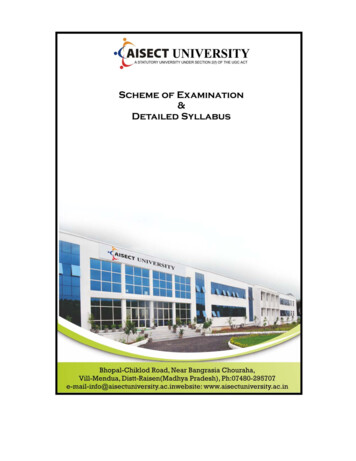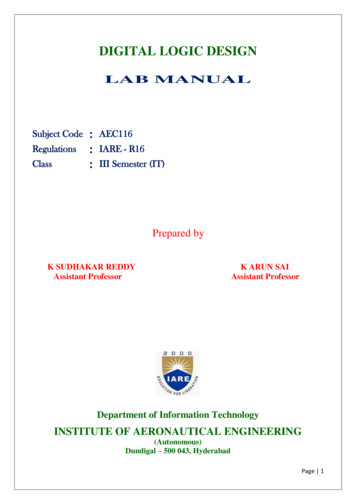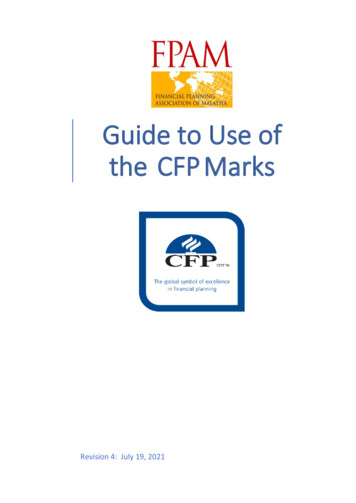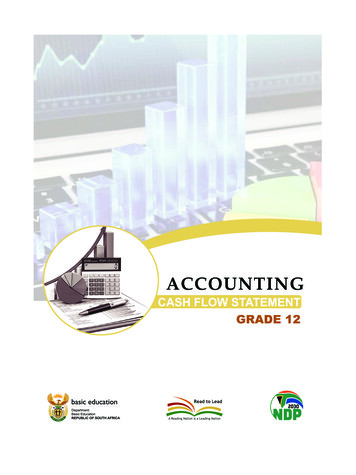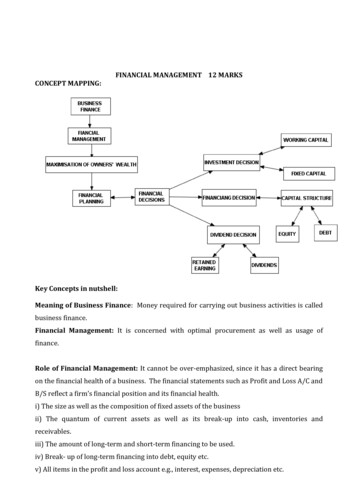
Transcription
CONCEPT MAPPING:FINANCIAL MANAGEMENT 12 MARKSKey Concepts in nutshell:Meaning of Business Finance: Money required for carrying out business activities is calledbusiness finance.Financial Management: It is concerned with optimal procurement as well as usage offinance.Role of Financial Management: It cannot be over-emphasized, since it has a direct bearingon the financial health of a business. The financial statements such as Profit and Loss A/C andB/S reflect a firm’s financial position and its financial health.i) The size as well as the composition of fixed assets of the businessii) The quantum of current assets as well as its break-up into cash, inventories andreceivables.iii) The amount of long-term and short-term financing to be used.iv) Break- up of long-term financing into debt, equity etc.v) All items in the profit and loss account e.g., interest, expenses, depreciation etc.
Objectives of Financial Management: Maximisation of owners’ wealth is sole objective offinancial management. It means maximization of the market value of equity shares. Marketprice of equity share increases if the benefits from a decision exceed the cost involved.FINANCIAL DECISIONS
Investment Decision: It relates to how the firm’s funds are invested in different assets .Investment decision can be long-term or short-term. A long-term investment decision is alsocalled a Capital Budgeting decision.Factors affecting Capital Budgeting Decision/Investment Decision:1. Cash flows of the project: If anticipated cash flows are more than the cost involved thensuch projects are considered.2. The rate of return: The investment proposal which ensures highest rate of return isfinally selected.3. The investment criteria involved: Through capital budgeting techniques, investmentproposals are selected.Financing Decision: - It refers to the quantum of finance to be raised from various sources oflong-term of finance. It involves identification of various available sources. The main sourcesof funds for a firm are shareholders funds and borrowed funds. Shareholders funds refer toequity capital and retained earnings. Borrowed funds refer to finance raised as debentures orother forms of debt.Factors Affecting Financing Decision:a) Cost: The cost of raising funds through different sources is different. A prudent financialmanager would normally opt for a source which is the cheapest.(b) Risk: The risk associated with different sources is different.(c) Floatation Costs: Higher the floatation cost, less attractive the source.(d) Cash Flow Position of the Business: A stronger cash flow position may make debtfinancing more viable than funding through equity.(e) Level of Fixed Operating Costs: If a business has high level of fixed operating costs (e.g.,building rent, Insurance premium, Salaries etc.), It must opt for lower fixed financing costs.Hence, lower debt financing is better. Similarly, if fixed operating cost is less, moref) Control Considerations: Issues of more equity may lead to dilution of management’scontrol over the business. Debt financing has no such implication. Companies afraid of atakeover bid may consequently prefer debt to equity.g) State of Capital Markets: Health of the capital market may also affect the choice of sourceof fund. During the period when stock market is rising, more people are ready to invest inequity. However, depressed capital market may make issue of equity shares difficult for anycompany.
DIVIDEND DECISION:-The decision involved here is how much of the profit earned bycompany (after paying tax) is to be distributed to the shareholders and how much of it shouldbe retained in the business for meeting the investment requirements.FACTORS AFFECTING DIVIDEND DECISION:a) Earnings: Dividends are paid out of current and past earning. Therefore, earnings is amajor determinant of the decision about dividend.(b) Stability of Earnings: Other things remaining the same, a company having stable earningis in a position to declare higher dividends. As against this, a company having unstableearnings is likely to pay smaller dividend.c) Stability of Dividends: It has been found that the companies generally follow a policy ofstabilising dividend per share.(d) Growth Opportunities: Companies having good growth opportunities retain moremoney out of their earnings so as to finance the required investment.(e) Cash Flow Position: Dividends involve an outflow of cash. A company may be profitablebut short on cash. Availability of enough cash in the company is necessary for declaration ofdividend by it.(f) Shareholder Preference: While declaring dividends, managements usually keep in mindthe preferences of the shareholders in this regard.(g) Taxation Policy: The choice between payment of dividends and retaining the earnings is,to some extent, affected by difference in the tax treatment of dividends and capital gains.(h) Stock Market Reaction: Investors, in general, view an increase in dividend as a goodnews and stock prices react positively to it. Similarly, a decrease in dividend may have anegative impact on the share prices in the stock market.(i) Access to Capital Market: Large and reputed companies generally have easy access to thecapital market and therefore may depend less on retained earnings to finance their growth.These companies tend to pay higher dividends than the smaller companies which haverelatively low access to the market.(j) Legal Constraints: Certain provisions of the Company’s Act place restrictions on payoutsas dividend. Such provisions must be adhered to while declaring the dividends.(k) Contractual Constraints: While granting loans to a company, sometimes the lender mayimpose certain restrictions on the payment of dividends in future.
FINANCIAL PLANNINGFinancial Planning is essentially preparation of financial blueprint of an organisations’sfuture operations. The objective of financial planning is to ensure that enough funds areavailable at right time.OBJECTIVES(a) To ensure availability of fundswhenever these are required: This include a properestimation of the funds required for different purposes such as for the purchase of long-termassets or to meet day- to- day expenses of business etc.(b) To see that the firm does not raise resources unnecessarily: Excess funding is almostas bad as inadequate funding.IMPORTANCE OFFINANCIAL PLANNING(i) It tries to forecast what may happen in future under different business situations. By doingso, it helps the firms to face the eventual situation in a better way. In other words, it makes thefirm better prepared to face the future.(ii) It helps in avoiding business shocks and surprises and helps the company in preparing forthe future.(iii) If helps in co-ordinating various business functions e.g., sales and production functions,by providing clear policies and procedures.(iv) Detailed plans of action prepared under financial planning reduce waste, duplication ofefforts, and gaps in planning.(v) It tries to link the present with the future.(vi) It provides a link between investment and financing decisions on a continuous basis.(vii) By spelling out detailed objectives for various business segments, it makes the evaluationof actual performance easier.CAPITAL STRUCTURE: Capital structure refers to the mix between owners and borrowedfunds.FACTORS AFFECTING THE CHOICE OF CAPITAL STRUCTURE1. Cash Flow Position: Size of projected cash flows must be considered before issuing debt.2. Interest Coverage Ratio (ICR): The interest coverage ratio refers to the number of timesearnings before interest and taxes of a company covers the interest obligation.3. Debt Service Coverage Ratio(DSCR): Debt Service Coverage Ratio takes care of thedeficiencies referred to in the Interest Coverage Ratio (ICR).
4. Return on Investment (RoI): If the RoI of the company is higher, it can choose to usetrading on equity to increase its EPS, i.e., its ability to use debt is greater.5. Cost of debt: A firm’s ability to borrow at a lower rate increases its capacity to employhigher debt. Thus, more debt can be used if debt can be raised at a lower rate.6. Tax Rate: Since interest is a deductible expense, cost of debt is affected by the tax rate.7. Cost of Equity: Stock owners expect a rate of return from the equity which iscommensurate with the risk they are assuming. When a company increases debt, the financialrisk faced by the equity holders, increases.8. Floatation Costs: Process of raising resources also involves some cost. Public issue ofshares and debentures requires considerable expenditure. Getting a loan from a financialinstitution may not cost so much.9. Risk Consideration: As discussed earlier, use of debt increases the financial risk of abusiness.10. Flexibility: If a firm uses its debt potential to the full, it loses flexibility to issue furtherdebt.11. Control: Debt normally does not cause a dilution of control.12. Regulatory Framework: Every company operates within a regulatory frameworkprovided by the law e.g., public issue of shares and debentures has to be made under SEBIguidelines.13. Stock market conditions: If the stock markets are bullish, equity shares are more easilysold even at a higher price. However, during a bearish phase, a company may find raising ofequity capital more difficult and it may opt for debt.14. Capital Structure of other companies: A useful guideline in the capital structureplanning is the debt-equity rations of other companies in the same industry. There areusually some industry norms which may help.MANAGEMENT OF FIXED CAPITALFixed capital refers to investment in long-term assets. Management of fixed capitalinvolves around allocation of firm’s capital to different projects or assets with long-termimplications for the business. These decisions are called investment decisions or capitalbudgeting decisions and affect the growth, profitability and risk of the business in the longrun. These long-term assets last for more than one year.
IMPORTANCE OF CAPITAL BUDGETING DECISIONS(i) Long-term growth and effects: These decisions have bearing on the long-term growth.The funds invested in long-term assets are likely to yield returns in the future.(ii) Large amount of funds involved: These decisions result in a substantial portion ofcapital funds being blocked in long-term projects(iii) Risk involved: Fixed capital involves investment of huge amounts. It affects the returnsof the firm as a whole in the long-term. Therefore, investment decisions involving fixed capitalinfluence the overall business risk complexion of the firm.(iv) Irreversible decisions :These decisions once taken, are not reversible without incurringheavy losses.FACTORS AFFECTING THE REQUIREMENT OF FIXED CAPITAL1. Nature of Business: The type of business has a bearing upon the fixed capitalrequirements. For example, a trading concern needs lower investment in fixed assetscompared with a manufacturing organisation.2. Scale of Operations: A larger organisation operating at a higher scale needs bigger plant,more space etc. and therefore, requires higher investment in fixed assets when comparedwith the small organisation.3. Choice of Technique: Some organisations are capital intensive whereas others are labourintensive. A capital-intensive organisation requires higher investment in plant and machineryas it relies less on manual labour.4. Technology Up gradation: In certain industries, assets become obsolete sooner.Consequently, their replacements become due faster. Higher investment in fixed assets may,therefore, be required in such cases.5. Growth Prospects: Higher growth of an organisation generally requires higher investmentin fixed assets.6 .Diversification: A firm may choose to diversify its operations for various reasons, Withdiversification, fixed capital requirements increases.7. Financing Alternatives: A developed financial market may provide leasing facilities as analternative to outright purchase. Availability of leasing facilities, thus, may reduce the fundsrequired to be invested in fixed assets, thereby reducing the fixed capital requirements. Sucha strategy is specially suitable in high risk lines of business.8. Level of Collaboration: At times, certain business organisations share each other’sfacilities. For example, a bank may use another’s ATM or some of them may jointly establish aparticular facility. Such collaboration reduces the level of investment in fixed assets for eachone of the participating organisations.
WORKING CAPITAL REQUIREMENTSNet working capital may be defined as the excess of current assets over current liabilities.FACTORS AFFECTING WORKING CAPITAL REQUIREMENTS1. Nature of Business: Trading Organisations – Less working capitalManufacturing Organisations – more working capital2. Scale of Operations: Large scale organizations – more working capitalSmall scale organizations – less working capital3. Business Cycle: Boom period - more working capitaDepression period - less working capital4. Seasonal factors: Peak season – more working capitalLean season – less working capital5. Production cycle: Longer production cycle – more working capitalShorter production cycle – less working capital6. Credit allowed: Conservative/strict credit policy – less working capitalLiberal credit policy – more working capital7. Credit availed: If credit is available easily from suppliers - less working capitalIf credit is not available easily from suppliers – more working capital8. Operating efficiency: If current assets are managed efficiently – less working capitalIf current assets are not managed efficiently – more working capital9. Availability of Raw Material: Easy and timely availability of raw material – less workingcapitalDifficulty and lengthy time period are involved in getting raw materials – more workingcapital10. Growth Prospects: If there is possibility of growth potential - more working capitalIf there is no possibility of growth – less working capital11. Level of Competition: If there is stiff and cut-throat competition – more working capitalLess competition and monopoly like situation – less working capital12. Inflation : During inflation – more working capitalDuring recession – less working capital
FINANCIAL LEVERAGE/CAPITAL GEARING/ TRADING ON EQUITYIt is an assumption that by using fixed charge bearing securities in the capital structureof a company, return to the equity shareholders can be increased. But this is possible onlywhen the rate of return of the company is higher than the rate interest which a company payson its debt capital.For example a company has Rs.10 crores capital. Option 1 the company uses onlyequity capital Option 2 the company uses 50% equity and 50% debt capital in its capitalstructure. Rate of interest on debt is 15%. Rate of Income-tax is 30% . Profit before interestand tax is Rs.2 crores.ParticularsProfit bebore interest and taxes(PBIT)Less: Interest on debtProfit after taxLess: Income – tax @30%Profit after tax and interestNo. of equity shares ( FV Rs.10each)Return to shareholders(EPS)Option 1Option 50,00020,00,00010,00,000Rs. 7Rs.12.95Questions (with some hints wherever necessary)Important questions are shown with * mark and the Most important questions areshown with ** mark*1. Name the cheapest source of finance to a company.1MAns. Debt capital2. Name the decision to acquire a new and modern plant to upgrade an old one.1MAns. Investment decision**3. What is meant by Capital Structure?1M**4. Enumerate three important decisions taken in financial management.1M5. What is the link between operating cycle and working capital?1M**6. Canara Bank wants to open a new branch of his bank? What is this decision called? 1MAns. Investment decision*7. What is the cost of raising funds called?Ans. Floatation cost1M
8. Why investors want dividend?1M9. Define business finance.1M10. How the EPS is computed?1MAns. Earnings available for equity shareholders/No. of equity shares11. How the Interest Coverage Ratio is computed?1MAns. EBIT/Interest12. How the Return on Investment is computed?1MAns. EBIT/Capital Employed X 100*13. Which is the most costly capital for a company?1MAns. Equity share capital14. Name the concept which increases the return on equity shares with a change in thecapital structure of a company.1MAns. Trading on Equity**15. State why the working capital needs for a ‘Service-industry’ are different fromthat of a Manufacturing industry.1MAns. Service industries need less working capital because they do not require any inventory.They do not have any manufacturing process.**16. Name any two essential ingredients of sound working capital management.1MAns. Inventory, debtors**17. ‘Cost of debt’ is lower than the ‘cost of equity share capital’ Give reasons why eventhen a company cannot work only with the debt.1MAns. A company cannot exist without equity share capital*18. What is meant by Gross working capital?1MAns. Total investment on current assets (Current liabilities should not be deducted)19. Name that portion of current assets which is financed by fixed liabilities.1MAns. Net working capital20. Why is working capital needed? Give any one reason.1MAns. It is required to meet day to day expenses.21. Discuss two objectives of financial planning.3M22. What is financial risk? Why does it arise?3M23. Define current assets and give four examples.3M
24. Financial management is based on three broad financial decisions. What are these?3M**25. What is the main objective of financial management?3M26. Discuss about working capital affecting both liquidity as well as profitability of abusiness.3MHint: The working capital should neither be more or less than required. Both these situationsare harmful. It is considered as a necessary evil.27. How does cost of capital affect the capital structure of a company?3M*28. “Sound Financial Management is the key to the prosperity of business: Explain3MHint: Role of financial management*29. Explain the factors affecting the investing decision of a company.3M30. State the two important objectives of financial planning.3MHint: i) To ensure timely availability of finance ii) To ensure proper balance of finance.31. Explain the meaning of Fixed Capital. Explain any two factors that determine thefixed capital of a company.3M32. What is the role of ‘Leasing’ in determining the requirement of fixed capital?3M33. ‘Fixed capital decisions involve more risk’ How?3M34. How ‘scale of operations’ affect the requirement of fixed capital?3M35. Length of production cycle affects the working capital requirements of anorganisation. Explain3M36. How are ‘Growth Prospects’ related with the requirement of working capital?3M37. How does ‘Risk consideration’ affect the capital structure decision?3M38. How ‘Capital Structure of other companies’ affects the capital structure decision?3M39. What do you mean by Financial Leverage?3MHint: Trading on equity40. Explain the ‘Earnings Before Interest and Taxes’ - EBIT3M41. “Share Capital is better than debt capital” In the favour of this statement explainone factor which affects the capital structure.3MHint: Cash flow position or other relevant point which favours equity capital42. When debt capital is cheaper than the equity capital, why don’t companies go fordebt capital alone?3MHint: A public company cannot be incorporated without equity share capital43. How the control of existing shareholders affects? How this situation can beavoided?3M
Hint: This situation can be avoided by raising debt capital rather than equity capital44. “Tax benefit is available only in case of payment of interest and not on the paymentof preference dividend “Why3MHint: Interest on debt only tax deductable expense but not preference dividend.45. ‘Capital structure decision is essentially optimization of risk-return relationship’Comment4M46. A Capital budgeting decision is capable of changing the financial fortune of abusiness. Do you agree? Why or Why not?4M47. What is the importance of capital budgeting decisions?4M**48. To avoid the problems of shortage and surplus of funds what is required infinancial management? Name the concept and explain its any three points ofimportance.4MHint: Financial Planning.49. Explain briefly any four points of the role of financial management.4M50. To tackle the uncertainty in respect of availability and timings of funds what isrequired? Name the concept involved and explain its three points of importance.4MHint: Financial planning**51. Name the process which helps in determining the objectives, policies, procedures,programmes and budgets to deal with the financial activities of an enterprise. Explainits three points of importance.4MHint: Financial Planning52. Explain by giving any four reasons, why capital budgeting decisions are important.4M53. What is the meaning of Financial Planning? Why is it important? Give any tworeasons.4M**54. Explain the factors affecting the dividend decision.5M**55. Explain the term ‘Trading on Equity’. Why, When and How it can be used by abusiness organisation?5M56. “A sound financial plan is the key to success of sound financial management of thecompany” Discuss5MHint: Importance of Financial Planning.*57. How can the return on equity be increased by using debt in the capital structure?Illustrate with a suitable example.5MHint: Trading on equity.58. “Financial planning does not serve any useful purpose” CommentHint: No, Explain the importance5M
**59. A businessman who wants to start a manufacturing concern approaches you tosuggest him whether the following manufacturing concerns would require large orsmall working capital:i) Bread ii) Sugar iii) Furniture manufacturing against specific order iv) Cool ers v)Motor Car5MHint: i) Bread – less ii) Sugar – More iii) Furniture manufacturing against specific order –less iv) Coolers – More v) Motor Car - More.60. What is meant by financial management? Explain any three decisions involved in it. 5M**61. Explain the meaning of fixed capital. Briefly explain any four factors thatdetermine the fixed capital of a company.5M62. Explain any five factors which affect the dividend policy of a company.5M63. “Financial Planning does not serve any useful purpose” Comment5M64. How are shareholders likely to gain with a loan component in the capital employed?Briefly explain5MHint: Trading on equity**65. “Determining the overall cost of capital and the financial risk of the enterprisedepends upon various factors.” Explain any five such factors.5MHint: Factors affecting capital structure**66. You are a Finance Manager of a newly established company. The Directors haveasked you to determine the amount of Fixed Capital requirement for the company.Explain any four factors that you will consider while determining the fixed capitalrequirement for the company.6M**67. What is working capital? How is it calculated? Discuss five importantdeterminants of working capital requirements.6M**68. Explain any six factors which affect the capital structure of a company.6M**69. What is fixed capital management? Explain any five factors determining theamount of fixed capital.6M70. What is meant by financial management? Explain its role.6M**71. Explain any six factors affecting the financing decision of a company.6M72. Explain any six factors affecting the dividend decision of a company.6M73. What do you mean by financial planning? Discuss the importance of financialplanning in financial management.6M74. The Board of Directors has asked you to design the capital structure of thecompany. Explain any six factors that you would consider while doing so.6M75. “Determination of capital structure of a company is influenced by a number offactors” Explain any four such factors6M
CHAPTER 10FINANCIAL MARKETS8MarksCONCEPT MAPPING:
Key Concepts in nutshell:CONCEPT OF FINANCIAL MARKET:It refers to the market which creates and exchanges financial assets.FUNCTIONS OF FINANICIAL MARKET1. Mobilization of savings and channeling them into the most productive uses: Afinancial market facilitates the transfer of savings from savers to investors (industries)2.Facilitates price discovery: In the financial market, the households are suppliers of fundsand business firms represent the demand. The interaction between them helps to establish aprice for the financial asset which is being traded in that particular market.3. Provide liquidity to financial assets: Financial markets facilitate easy purchase and saleof financial assets. In doing so they provide liquidity to financial assets, so that they can beeasily converted into cash whenever required.4. Reduce the cost of transactions: Financial markets provide valuable information aboutsecurities being traded in the market. It helps to save time, effort and money.
Instruments:1. Treasury Bill (T-bills): It is basically an instrument of short-term borrowing by theGovernment of India maturing in less than one year. They are also known as Zero CouponBonds.
2. Commercial Paper:It is a short-term unsecured promissory note, negotiable andtransferable by endorsement and delivery with a fixed maturity period. It is issued by largeand creditworthy companies to raise sort-term funds at lower rates of interest than marketrates. It usually has a maturity period of 15 days to one year.3. Call Money: It is a short-term finance repayable on demand, with a maturity period of oneday to fifteen days, used for inter-bank transactions. It is a method by which banks borrowfrom each other to be able to maintain the cash reserve ratio.4. Certificate of Deposit (CD): It is a unsecured, negotiable short-term instruments in bearerform, issued by commercial banks and development financial institutions. It can be issued toindividuals, corporations and companies.5. Commercial Bill (Trade Bill): It is a short-term , negotiable, self-liquidating instrumentwhich is used to finance the credit sales of firms. The bill can be discounted with a bank if theseller (drawer) needs funds before the bill maturity.TYPES OF CAPITAL MARKET:Primary Market: It is also known as the new issues market. It deals with new securitiesbeing issued for the first time. A company can raise capital through the primary market in theform of equity shares, preference shares, debentures, loans and deposits.
Secondary Market: It is also known as stock market or stock exchange or second-handmarket. It is a market for the purchase and sale of existing securities.Difference between Primary Market and Secondary MarketPrimary MarketSecondary Market1. It is the market for newsecurities.2. Securities are exchangedbetween company and theinvestors.3. It promotes capital formationdirectly.4. Only buying of securities takesplace. Securities cannot be soldhere.5. There is no fixed geographicallocation.6. Prices are determined anddecided by the management ofthe company.7. Securities are issued toinvestors for the first time.1. It is the market for existingsecurities.2. Securities are exchanged betweeninvestors.3. It promotes capital formationindirectly.4. Both buying and selling ofsecurities can take place in the stockexchange / stock market.5. There is a specified location.6. Prices are determined by demandand supply for the security in thestock exchange.7. Securities may be bought and soldmany times but not the first time.Methods of Floatation:Following are the methods of raising capital from the primary market : 1. Public issue through prospectus: under this method the company wanting to raisecapital issues a prospectus to inform and attract the investing public.It invitesprospective investors to apply for the securities. 2.Offer for sale: under this method the sale of securities takes place in two steps. Inthe first step the company sells the entire lot of shares to the intermediary firms ofstock brokers at an agreed price .In the second step, the intermediary resells theseshares to investors at a higher price. 3. Private placement: In private placement the entire lot of new securities ispurchased by an intermediary at a fixed price and sold not to the public but to selectedclients at a higher price. 4 .Rights issue (for existing companies: This is the offer of new shares (additionalshares) by an existing company to the existing shareholders. The shareholder mayeither accept the offer for himself or assign to another. A rights issue to the existingshareholders is a mandatory requirement.
5. e-IPOs: A company proposing to issue capital to the public through the on-linesystem of the stock exchange has to enter into an agreement with the stock exchange.This is called an Initial Public Offer (IPO). The issuer company should also appoint aregistrar to the issue having electronic connectivity with the exchange.STOCK EXCHANGE Meaning and definition of Stock exchange: The stock exchange is a market in whichexisting securities are bought and sold. The securities contract (regulation) act, 1956 defines “a stock exchange as anassociation, organization, body of individuals, whether incorporated or not,established for the purpose of assisting, regulating and controlling of business inbuying, selling and dealing in securities”.Functions of stock exchange1. Providing Liquidity and Marketability to Existing Securities: It gives investors thechance to disinvest and re-invest. This provides both liquidity and easy marketability toalready existing securities in the market.2. Pricing of Securities: Share prices on a stock exchange are determined by the forces ofdemand and supply. A stock exchange is a mechanism of constant valuation through whichthe prices of securities are determined.3. Safety of Transactions: The membership of a stock exchange is well regulated and itsdealings are well defined according to the existing legal frame work. This ensures that theinvesting public gets a safe and fair deal on the market.4. Contributes to Economic Growth: A stock exchange is a market in which exis
Role of Financial Management: It cannot be over-emphasized, since it has a direct bearing on the financial health of a business. The financial statements such as Profit and Loss A/C and B/S reflect a firm's financial position and its financial health. i) The size as well as the composition of fixed assets of the business

